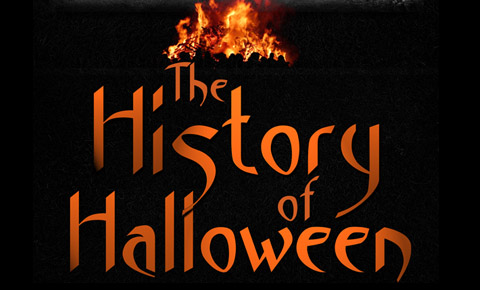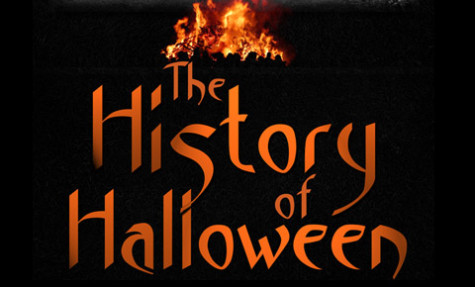Hallowistory
The History of Halloween

Hallowistory
The History of Halloween
By Nathan W.
BOO! Did that scare you? Of course it did. With Halloween right around the corner, spOoOokyness is in the air! But why? Who? When and Where? How has this grim and grand tradition come to be what it is in the U.S. today? Strap on your rubber underwear and plug in the night light, because we’re about to hear the story… OF HALLOWEEN!
Our story begins a long time ago, in a time I like to call history! More specifically, between 1,000 and 100 B.C., in ancient Europe where the Celtic people would celebrate their tradition of Samhain (pronounced Sow-in) around November 1st, which was the Celtic New Year. However, Celts were weird. Instead of getting drunk and kissing at midnight, they would get drunk, light bonfires, and walk around dressed as ghosts to ward off roaming spirits. You see, the Celts believed that the line between living and dead was blurred on the new year, and ghosts would walk among the living, killing crops and telling prophecies to Druids (Celtic priests). To commemorate the event, Druids built sacred bonfires where the people would go and burn their stuff to appease their deities (as opposed to today when we do it just for fun). The Celts would don costumes made of animal skins, try to tell each other’s fortunes, and, when it was all done, they would each take a torch of sacred flame to light their hearth fires. Spooky, right? Well, not for long.
Like all things back in the day, Christianity came along and made some major changes. By this point, the Romans had made some minor alterations, but the biggest changes came when Pope Boniface IV dedicated the Pantheon in Rome to all the Christian martyrs, and renamed the holiday “All Martyrs Day”. That’s not too bad, we’ve still got dead people, the pool has just shrunk a little. But then, Pope Gregory III changed it again to include saints as well as martyrs. Living people? This is not what I signed up for! And this new holiday went on for hundreds of years! Thankfully, in 1000 A.D., the church changed it again to All Souls Day. Now we’ve gotten back to the ghosts! It was even celebrated similarly to Samhain: bonfires, parades, costumes, not so many animal skins, but that was a mess to clean up anyways. It was also called All-Hallows or, the night before, All-Hallows Eve which turned into Halloween! Yes, you heard it! That’s the big word that we’ve all been waiting for! We made it, right? That’s it?
WRONG! That Halloween was just a bell pepper compared to the spicy ghost pepper that is Halloween today! And it wouldn’t change again until the second half of the nineteenth century in America. The huge burst of immigrants, especially Irish, to the U.S. helped popularize the holiday on a national level, spreading tradition as they traveled from place to place while looking for work. Taking from Irish and English traditions, Americans began dressing up and going door to door, asking for food or money. Sound familiar? It’s the very first instance of Trick-or-Treating! Now we’re talking! Later in the century, there was a movement to make Halloween a more community centered holiday; to have more neighborly get-togethers and put on plays rather than playing tricks and witchcraft. It became the norm for people to throw Halloween parties for adults and children. Parties focused on games, foods of the season and festive costumes. Parents were encouraged by newspapers and community leaders to take anything “frightening” or “grotesque” out of Halloween celebrations. Due to this, Halloween lost much of its superstitious overtones and became more family friendly.
By the 1920’s and ‘30s, Halloween had become a strong community holiday, albeit secular. Communities would throw town-wide parades and parties that everyone could attend. They had a minor vandalism problem, but it was all cleared up by the ‘50s. Due to the high number of children born in the baby boom, Halloween became a holiday mostly targeted towards children. Parties moved from civic centers to homes and schools as thousands of tiny feet hit the street, clothed in fake toes and pointy boots. Yes, the century old tradition of trick-or-treating had returned and continued until the modern day, where Americans spend roughly $6 billion a year on candy alone!
And that is the story of Halloween! From the ancient Celts to your mom as a child, Halloween has changed in many ways, but stayed the same in many ways as well. At its heart, Halloween will always be about that special time of the year when monsters come out to play with the living and strangers give me things for free.
Our story may be finished, but we’re not done here yet! After my research, I went out and asked one of my classmates, Anna Cressey, where she thought Halloween came from. Here’s what she said:
“I have no idea what the history of Halloween is, but I think that, back in the day, people used to do something similar to what we do now and… it’s just tradition!”
Another classmate, Adia Grogan, said:
“It came from Ireland and they used to carve potatoes to keep away bad spirits.”
Whether you were an expert, or had no idea whatsoever, I’m sure that we can all have an idea about 
